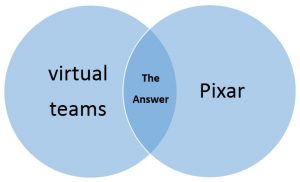10.8: What If You Can’t Find Sources?
Are There No Sources for My Topic?
As a college librarian, Patricia Knapp worked with many students who were new to academic research and writing. She noticed that such inexperienced researchers often “have a basic misconception of the function” of research: “they look for and expect to find ‘the answer to the question’ instead of evidence to be examined” (as cited in Kuhlthau, 2004, p. 10 10).
What should researchers do instead? The so-called “divide and conquer” strategy works in most contexts: dividing the research question/ problem into components aspects and looking for sources on each of those aspects.
Here’s an example:
Our research question is, “How can virtual teams be implemented at Pixar Animation Studios?”
An inexperienced researcher might want to dive right into a library database to find “the answer” to the question, with a search like this: “virtual teams” AND Pixar
This attitude derives from the assumption that there is a ready-made answer to the research question, as represented in this Venn diagram, and one just has to quickly search for it and locate it:

However, a) chances are no one has ever published an article about virtual teams at Pixar, so the search would yield zero results, and b) research isn’t about finding “the answer”—it’s about finding ideas and facts you can use to create your own answer. So, how should you proceed?
You should divide the question into two parts you can “conquer”:
- First, you should research virtual teams (challenges, best practices, etc.).
- Next, you should research Pixar (its mission, corporate culture, etc.).
Accordingly, your two separate database searches might look like this:
- “virtual teams” AND (challenges OR “best practices”)
- Pixar AND “corporate culture”
A journal article that you might choose from the first search is by Soo Jeoung Han et al., “How Virtual Team Leaders Cope with Creativity Challenges,” in which the authors study ways that creativity can be fostered in virtual teams. From your second search, you might use an article from Harvard Business Review by Pixar cofounder Ed Catmull, “How Pixar Fosters Collective Creativity.”
By putting these two texts—Han et al. (2017) and Catmull (2008)—into conversation, you can begin to develop your own argument on implementing virtual teams at Pixar. You might begin with the observation that, according to Han et al., the qualities of an effective creative team are the same, whether it is virtual or in-person. Because, as Catmull (2008) notes, Pixar already has such a strong team culture, the company would be well positioned to implement virtual teams: they have formed close relationships, strive to create a space where it’s safe to bring up new ideas or critique others’ ideas, and group members at all levels of the company support one another and take on leadership roles. You could emphasize some promising parallels between the key findings from Han et al. (2017) and the vibrant group culture at Pixar.
Once you’ve started putting the two texts into dialogue, you would probably see more connections. For instance, an interesting claim from Han et al. (2017) is that using state-of-the-art technology to communicate can be a motivating factor in itself. Catmull (2008) tells us that, at Pixar, “Technology inspires art, and art challenges the technology” (p. 71). Given the fascination with technology at Pixar, members of virtual teams would likely be motivated to participate because of the opportunity to experiment with the newest forms of digital communication.
By orchestrating an interplay between your two sources, putting them in dialogue with each other and with your own ideas, you can offer an original analysis. “Conquering” your research question means offering this analysis—your thinking, visible on the page. This is what professors—and all genuinely interested readers—want to see.
The rhetorician Kenneth Burke famously described academic writing as a conversation that has been taking place among various authors, across time, on a given topic. Your task, as an academic writer, is to add something new to this conversation. You may think of academic writing and creative writing as separate, especially if you’ve been taught to exclude your own voice and opinions from school papers. But when you “divide and conquer,” gathering evidence you then use to contribute an original idea, academic writing is creative.
References
Burke, K. The philosophy of literary form: Studies in symbolic action. Vintage, 1957.
Catmull, E. (2008, September). “How Pixar fosters collective creativity.” Harvard Business Review 86(9), 64-72.
Han, S. J., et al. (2017, April). “How virtual team leaders cope with creativity challenges. European Journal of Training & Development 41(3), 261-276. DOI:10.1108/EJTD-10-2016-0073.
Kuhlthau, C. C. (2004). Seeking meaning: A process approach to library and information services (2nd ed.). Libraries Unlimited

